Ear and Hearing Process
In order to understand hearing loss, it is essential to be familiar with the anatomy of the ear, which consists of three main parts.
Parts of the Ear
External or Outer Ear: picks up sound waves from the air and directs them to the middle ear.
Middle Ear: turns sound waves into mechanical pressure waves and directs them to the inner ear fluids.
Inner Ear (Cochlea): converts pressure waves into electrical signals that the brain can understand.
How We Hear
In the hearing process, the ear is the medium that picks up sound waves and converts them into messages that the brain can understand. Without the ear, the brain cannot interpret these signals, which makes hearing impossible.
Sounds enter the ear canal: Sound waves move from the surrounding environment into the outer ear canal.
The eardrum and hearing bones (auditory ossicles) vibrate: Sound waves strike the eardrum, making it vibrate. These vibrations cause the auditory ossicles, the three small bones in the middle ear, to vibrate.
Fluid moves through the inner ear: This movement takes the vibrations to the cochlea (the spiral-shaped part of the inner ear) and through the fluid inside it, which causes waves similar to sea waves.
Transforming the vibrations into electrical nerve impulses and transferring them to the brain through the auditory nerve: The hair cells inside the cochlea pick up these vibrations and turn them into electrical nerve impulses. These nerve impulses are transferred to the brain through the auditory nerve. The brain interprets the impulses as sounds that are easy to understand and identify.



